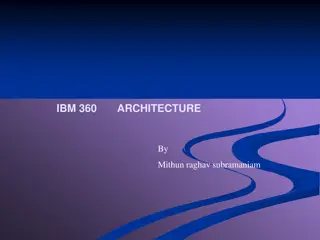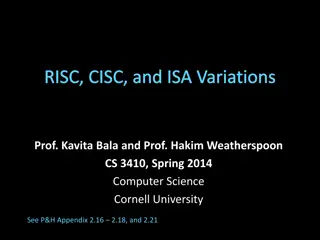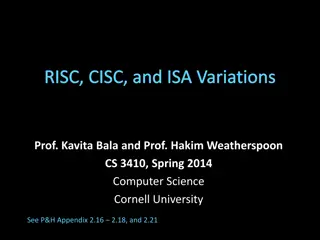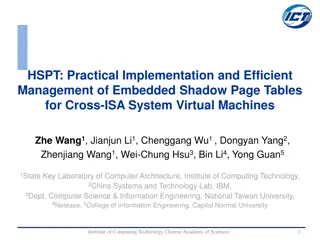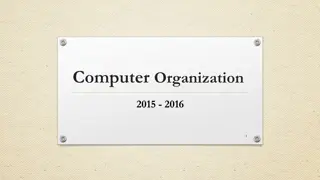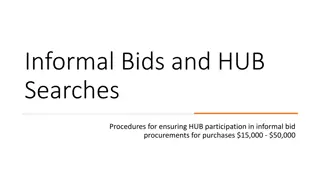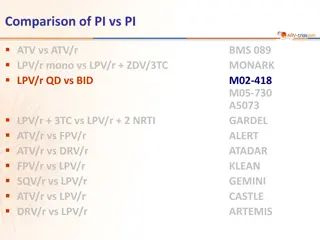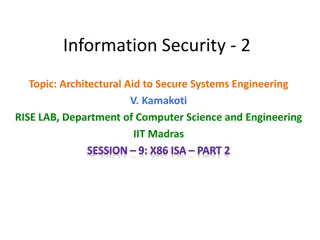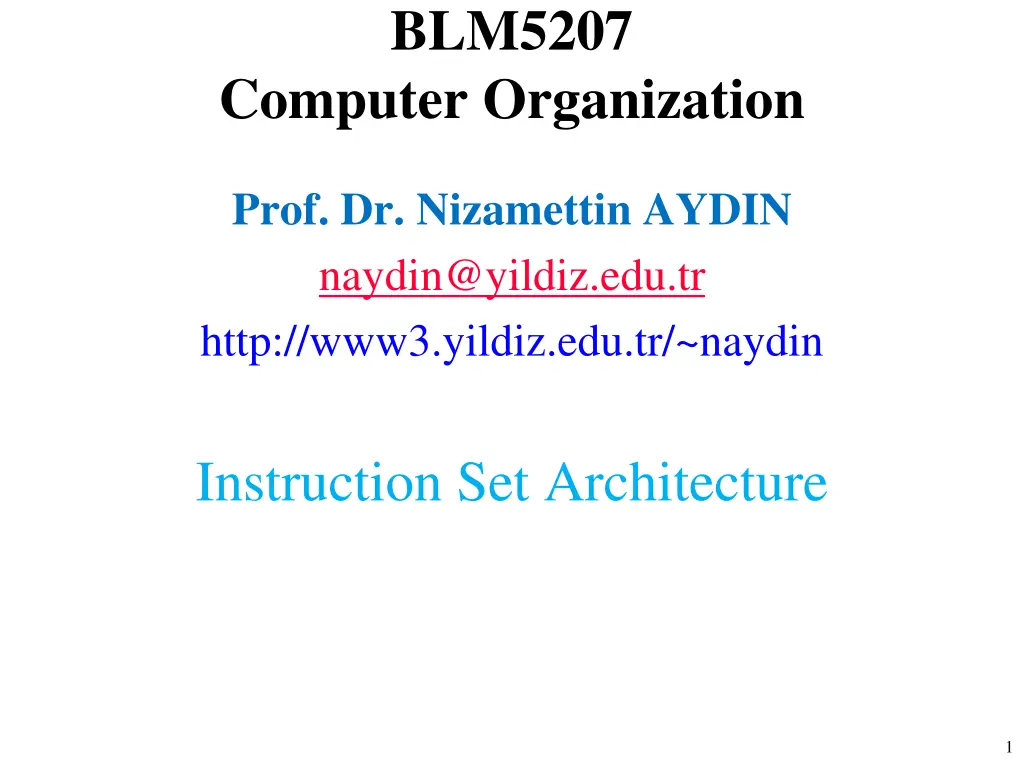
Understanding Computer Organization and Instruction Set Architecture
Learn about computer organization, instruction set architecture, machine language, assembly language, instruction types, elements of an instruction, operand locations, instruction representation, and simple instruction formats in this comprehensive guide.
Download Presentation

Please find below an Image/Link to download the presentation.
The content on the website is provided AS IS for your information and personal use only. It may not be sold, licensed, or shared on other websites without obtaining consent from the author. If you encounter any issues during the download, it is possible that the publisher has removed the file from their server.
You are allowed to download the files provided on this website for personal or commercial use, subject to the condition that they are used lawfully. All files are the property of their respective owners.
The content on the website is provided AS IS for your information and personal use only. It may not be sold, licensed, or shared on other websites without obtaining consent from the author.
E N D
Presentation Transcript
BLM5207 Computer Organization Prof. Dr. Nizamettin AYDIN naydin@yildiz.edu.tr http://www3.yildiz.edu.tr/~naydin Instruction Set Architecture 1
C Fortran Ada etc. Basic Java Compiler Compiler Byte Code Assembly Language Assembler Interpreter Executable Instruction Set Architecture HW Implementation 1 HW Implementation 2 HW Implementation N 2
Instruction Set Instruction: Language of the machine Instruction set: Vocabulary of the language (Collection of instructions that are understood by a CPU) lda, sta, brp, jmp, nop, ... (VVM) Machine Code machine readable Binary(example: 1000110010100000) Usually represented by assembly codes Human readable Example: VVM code adding a number entered from keyboard and a number in memory location 40 0 in 1 sta 30 2 add 40 3 sta 50 4 hlt 3
Instruction Types Data processing ADD, SUB Data storage (main memory) STA Data movement (I/O) IN, OUT, LDA Program flow control BRZ 4
Elements of an Instruction Operation code (Op-code) Do this Example: ADD 30 (VVM code) Source Operand reference To this Example: LDA 50 (VVM code) Result Operand reference Put the result here Example: STA 60 (VVM code) Next Instruction Reference When you have done that, do this... PC points to the next instruction 5
Source and Result Operands Source and Result Operands can be in one of the following areas: Main memory Virtual memory Cache CPU register I/O device 6
Instruction Representation In machine code each instruction has a unique bit pattern For human consumption a symbolic representation is used (assembly language) Opcodes are represented by abbreviations, called mnemonics indicating the operation ADD, SUB, LDA, BRP, ... In an assembly language, operands can also be represented as following ADD A,B (add contents of B and A and save the result into A) 7
Simple Instruction Format Following is a 16 bit instruction format So... What is the maximum number of instructions in this processor? What is the maximum directly addressable memory size? 8
Instruction Set Classification One way for classification: Number of operands for typical arithmetic instruction add $s1, $s2, $s3 3 What are the possibilities? Will use this C statement as an example: a = b + c; Assume a, b and c are in memory 9
Zero Address Machine a.k.a. Stack Machines Example: a = b + c; PUSH b PUSH c ADD # Push b onto stack # Push c onto stack # Add top two items # on stack and replace # with sum # Remove top of stack # and store in a POP a 10
One Address Machine a.k.a. Accumulator Machine One operand is implicitly the accumulator Example: a = b + c; # ACC # ACC # a b ACC + c ACC LOAD b ADD c STORE a A good example for such a machine is... VVM 11
Two Address Machine (1) a.k.a. Register-Memory Instruction Set One operand may be a value from memory Machine has n general purpose registers $0 through $n-1 Example: a = b + c; # $1 # $1 # M[a] M[b] $1 + M[c] $1 LOAD $1, b ADD $1, c STORE $1, a 12
Two Address Machine (2) a.k.a. Memory-Memory Machine Another possibility do stuff in memory! These machines have registers used to compute memory addresses 2 addresses (One address doubles as operand and result) Example: a = b + c; # M[a] # M[a] M[b] M[a] + M[c] MOVE a, b ADD a, c 13
Two Address Machine (3) a.k.a. Load-Store Instruction Set or Register- Register Instruction Set Typically can only access memory using load/store instructions Example: a = b + c; # $1 # $2 M[b] M[c] $1 + $2 $1 LOAD $1, b LOAD $2, c ADD $1, $2 # $1 STORE $1, a # M[a] 14
Three Address Machine a.k.a. Load-Store Instruction Set or Register-Register Instruction Set Typically can only access memory using load/store instructions 3 addresses (Operand 1, Operand 2, Result) May be a forth - next instruction (usually implicit) Needs very long words to hold everything Example: a = b + c; LOAD $1, b # $1 LOAD $2, c # $2 ADD $3, $1, $2 # $3 STORE $3, a # M[a] M[b] M[c] $1 + $2 $3 15
Types of Operand Addresses Operand is in the address Numbers (actual operand) Integer or fixed point floating point decimal Characters (actual operand) ASCII etc. Logical Data (actual operand) Bits or flags 17
Pentium Data Types 8 bit (byte), 16 bit (word), 32 bit (double word), 64 bit (quad word) Addressing in Pentium is by 8 bit units A 32 bit double word is read at addresses divisible by 4: 0100 1A 22 +0 +1 F1 +2 77 +3 18
PowerPC Data Types 8 (byte), 16 (halfword), 32 (word) and 64 (doubleword) length data types Fixed point processor recognises: Unsigned byte, unsigned halfword, signed halfword, unsigned word, signed word, unsigned doubleword, byte string (<128 bytes) Floating point IEEE 754 Single or double precision 20
Types of Operation Data Transfer Arithmetic Logical Conversion I/O System Control Transfer of Control 21
Data Transfer Need to specify Source Destination Amount of data May be different instructions for different movements Or one instruction and different addresses 22
Arithmetic Basic arithmetic operations are... Add Subtract Multiply Divide Increment (a++) Decrement (a--) Negate (-a) Absolute Arithmetic operations are provided for... Signed Integer Floating point? Packed decimal numbers? 23
Logical Bitwise operations AND, OR, NOT Example1: bit masking using AND operation (R1) (R2) (R1) AND (R2) Example2: taking ones coplement using XOR operation (R1) = 10100101 (R2) = 11111111 (R1) XOR (R2) = 01011010 = 10100101 = 00001111 = 00000101 24
An example - sending two characters in a word Suppose we wish to transmit characters of data to an I/O device, 1 character at a time. If each memory word is 16 bits in length and contains two characters, we must unpack the characters before they can be sent. To send the left-hand character: Load the word into a register AND with the value 1111111100000000 This masks out the character on the right 28
An example - sending two characters in a word Shift to the right eight times This shifts the remaining character to the right half of the register Perform I/O The I/O module reads the lower-order 8 bits from the data bus. To send the right-hand character: Load the word again into the register AND with 0000000011111111 Perform I/O 29
Conversion Conversion instructions are those that change the format or operate on the format of data. For example: Binary to Decimal conversion 30
Input/Output May be specific instructions IN, OUT May be done using data movement instructions (memory mapped) May be done by a separate controller (DMA) 31
Systems Control Privileged instructions CPU needs to be in specific state For operating systems use 32
Transfer of Control Branch For example: brz 10 (branch to 10 if result is zero) Skip e.g. increment and skip if zero Subroutine call c.f. interrupt call 33
Use of Stack 36
Pentium Conditions for Conditional Jump and SETcc Instructions 41
Byte Ordering How should bytes within multi-byte word be ordered in memory? Some conventions Sun s, Mac s are Big Endian machines Least significant byte has highest address Alphas, PC s are Little Endian machines Least significant byte has lowest address 45
Byte Ordering Example Big Endian Least significant byte has highest address Little Endian Least significant byte has lowest address Example Variable x has 4-byte representation 0x01234567 Address given by &x is 0x100 Big Endian 0x100 0x101 0x102 0x103 01 23 01 23 45 45 67 67 Little Endian 0x100 0x101 0x102 0x103 67 45 67 45 23 23 01 01 46
Representing Integers Decimal: 15213 int A = 15213; int B = -15213; long int C = 15213; Binary: 0011 1011 0110 1101 Hex: 3 B 6 D Linux/Alpha A Sun A Linux C Alpha C Sun C 6D 3B 00 00 00 00 6D 3B 00 00 6D 3B 00 00 00 00 3B 6D 3B 6D 00 00 00 00 Linux/Alpha B Sun B 93 C4 FF FF FF FF C4 93 Two s complement representation 47
Representing Pointers int B = -15213; int *P = &B; Alpha Address Alpha P A0 FC FF FF Hex: 1 F F F F F C A 0 Binary: 0001 1111 1111 1111 1111 1111 1100 1010 0000 01 00 00 00 Sun P Sun Address EF FF Hex: Binary: E F F F F B 2 C 1110 1111 1111 1111 1111 1011 0010 1100 Linux P FB 2C D4 F8 Linux Address Hex: Binary: B F F F F 8 D 4 1011 1111 1111 1111 1111 1000 1101 0100 FF BF Different compilers & machines assign different locations to objects 48
Representing Floats Float F = 15213.0; Linux/Alpha F Sun F 00 B4 6D 46 46 6D B4 00 IEEE Single Precision Floating Point Representation IEEE Single Precision Floating Point Representation IEEE Single Precision Floating Point Representation Hex: Binary: Binary: Binary: Hex: Hex: 4 6 6 D B 4 0 0 0100 0110 0110 1101 1011 0100 0000 0000 0100 0110 0110 1101 1011 0100 0000 0000 0100 0110 0110 1101 1011 0100 0000 0000 4 6 6 D B 4 0 0 4 6 6 D B 4 0 0 15213: 15213: 15213: 1110 1101 1011 01 1110 1101 1011 01 1110 1101 1011 01 Not same as integer representation, but consistent across machines Can see some relation to integer representation, but not obvious 49
Representing Strings Strings in C Represented by array of characters Each character encoded in ASCII format Standard 7-bit encoding of character set Character 0 has code 0x30 Digit i has code 0x30+i String should be null-terminated Final character = 0 Compatibility Byte ordering is not an issue Data are single byte quantities Text files generally platform independent Except for different conventions of line termination character(s)! char S[6] = "15213"; Linux/Alpha S Sun S 31 35 31 35 32 31 33 00 32 31 33 00 50


